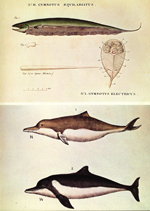Meeting 10 • 07 February 2013 • Thursday
|
Version: |
|
picture of the week |
thought-bite of the week: "In this paradise of American jungles, as everywhere else, a long , sad experience has taught all living beings that gentleness is rarely linked to might."(Humboldt, "Personal Narrative", from Jaguars and Electric Eels, ed. & trans. Wilson, p. 66) |
|
mini-text of the week (start): "In Calabozo, in the middle of the llanos, we found an electric machine with great discs, electrophori, batteries and electrometers…"Humboldt, "Personal Narrative", from Jaguars and Electric Eels, ed. & trans. Wilson, pp. 57-8, 62 (read more) |
|
√ |
(10') This week's thought-bite and mini-text: "Nature red in tooth and claw"; relation between human beings and Nature, and between mechanical and biological forces and substances. Sometimes the boundaries (or lack of boundaries) weren't understood: 1) Humboldt's battery with the bits of flesh between the disks. 2) Ancient technique of tempering a newly-forged (and still red hot) sword with (human) blood. 3) Astrological (and scientific!) beliefs about the interaction of extra-terrestrial bodies / forces on terrestrial organisms. 4) Anybody know people who use dowsers? What are the many meanings and applications (scientific or otherwise) of "change", "evolve", "evolution", "progress"? Followup on previous meeting's discussion of the words "science", "scientist", "natural philosophers": when did astronomy and astrology become pursuits that were distinct from each other? |
|
+ |
(10') Humboldt's enormous contribution to climate science and the origins of sustainabile environmentalism: the Chimborazo research and the iconic diagram – a brief look, followed by a look at some contemporary discussions. How far are we ourselves qualified to judge the science, and how far must we take the "facts" and "data" on "faith"? √A phrase that was used during the discussion, "But X is a fact," will give us a chance to explore the differences of meaning among "data", "fact", "conclusion", "theory", "opinion", "conviction", "truth", and whatever may lie underneath/ behind those words when it comes to acting on the data, facts, etc. |
|
+ |
(10') More about sources of errors in collecting and using data. Example 1: detecting non-solar planets; analyzing atmospheres of non-solar planets; are there ETs? Example 2: Measuring longitude: the margin for error in Humboldt's time. Some data-rich docs we can't spend much time on (but could be the subject of projects): the full narrative; economy of Mexico; later views of AvH: was he too data-driven to see the Big Picture? Or did he believe unwarrentedly in Big Picture of the Cosmos? Status of discussion at that time of the age of the Earth and the Universe |
| √ |
(10') presentation (continuation) about educational standards and their parts in the course: 1) evaluating own education – examples from the class about how to do the learning standards assignment; 2) helping others to learn - how standards are used to develop curriculum (curricula?) and learning activities – examples: Lyon Arboretum and Hawaii school standards • Hawaii STEM Intercommunity Portal Another example: SINQing the Humboldt canoe: 1) as material for discussion of curriculum: for math: age-appropriate activities; "spiral" syllabus; calculus?! AP?! Which other subject areas did we address / could be addressed? 2) food for thought: How do you know where you learned X? How do you know that what you learned is really true? How/When did you learn how to learn? If you lost your curiosity and interest in learning, how and when did it happen? |
|
+ |
(15') Second look at ideas for group projects: which skills do they need / which skills map onto which ideas? Examples of group projects from last year's Humboldt SINQ. Concept of "BIMP" – Big Idea for Major Project, rather than finished, packaged product. Reasons: a) never enough time; b) we're contemplating another SINQ (summer, maybe) and even a Humboldt Capstone. This course's group projects will be handed off (anonymously) to your successors for further development. Into the projects we'll integrate the species descriptions and the foundation for learning materials of use to Humboldt-named schools, or just about any school. You learn best when you have to teach what you've learned. To be an educated, committed citizen is both to learn and to teach. |
|
√ |
(15') Check your progress – and the related issue of assessment and grading; this applies to your recent writing assignment, to your performance in the course, and to your larger roles as citizen and (possibly) parent. Here's a self-evaluation guide for the middle of the term What assessment means (not just tests and assignments!) and how that relates to grades and curves and letting your light shine (or lightS - we each have our own strengths and weaknesses). Types of assessment: summative, formative; norm-referenced, criterion-referenced. What grades mean when they get beyond the letter itself (grad courses, major courses, 100-/200-level courses, SINQ courses). The issues of grade inflation and differential GPAs. |
|
√ |
(5') Announcements, Checkups & Previews: 1) midterm (outside class) is assigned TODAY; 2) what it's like to read Darwin; 3) Humboldt-named species; forming teams and scoping out projects; 4) the iconic graphic of Chimborazo; 5) apps Humboldt would have liked; 6) what shall we do with (to??) the people who haven't revealed their interests and strengths and don't get "on boa |
